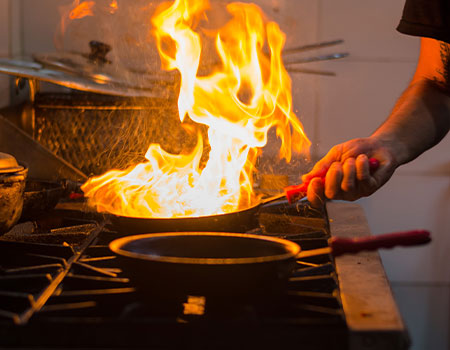class k fires can be extinguished by
Class A extinguishers are for use only on Class A fires. Along with having a Class K fire extinguisher readily accessible commercial kitchens should have their fire suppression systems installed by a professional fire.
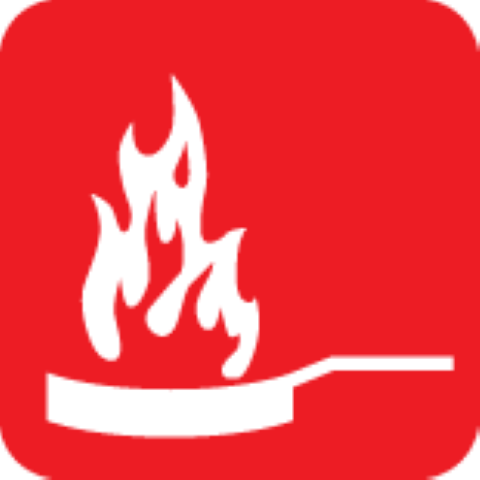
Learn About Portable Fire Extinguishers Fire Safety Learning Center
A Class A fire extinguisher is marked with a green triangle containing the letter A.

. Removing access to oxygen removing fuel inhibiting the chemical chain reaction and removing heat. To extinguish a Class D fire use a dry powder agent. Asked Jan 3 in Trades Technology by abritt.
Due to the higher heating rates of vegetable oils in commercial cooking appliances NFPA 10 Portable Fire Extinguishers now includes a Class K rating for kitchen fires extinguishers which are now required to be installed in all applicable restaurant kitchens. These liquids when brought up to high temperatures become volatile and can easily ignite. Class D fires generally require specific extinguishing agents or techniques to effectively extinguish them for example magnesium sodium and potassium fires can be extinguished with sodium chloride based dry powder while lithium fires can.
Class A fires involve ordinary combustible materials such as cloth wood paper rubber and many plastics. A K extinguisher can be used for larger-sized food fires although it is mainly used for cooking in commercial facilities and institutional kitchens. Extinguishers with an A rating are designed to extinguish fires involving these ordinary combustible materials.
Asked Jul 16 2019 in Trades Technology by dadaman. Once a fire starts in a deep fryer it cannot always be extinguished by traditional range hoods or Class B extinguishers. A Class A extinguisher is typically either a pressurized can of water that can be sprayed on a fire or a container of water with a pump mechanism.
Class K- Cooking oil fire- fryer oil grease lard etc. Fun fact class B class C class D and class K fires cannot be extinguished by water. Class K fires can only be extinguished with Class K extinguishers and should never be sprayed with water as this can increase the spread of the cooking liquids.
Extinguishment usually provided by saponification systems mounted on overhead vents or near fryer units. These extinguishers work by interrupting the chemical reaction at work in the fire triangle. Or you can cut off the oxygen by covering a burning pot with a lid.
The discharge stream can cause the spread of the flammable liquid in the case of a Class B fire or could cause shock hazards in a Class C fire. A Class K fire is defined as a cooking fire involving combustion from liquids used in food preparation. Class A B and C fires may be extinguished using a multipurpose dry chemical fire extinguisher.
Dry and Wet Agents to Extinguish Class K Fires. Grease and oil flames and are made from Class B or Class K coated extinguisher. These types of extinguishers work by cutting off a fires oxygen supply.
Up to 24 cash back Class A fires can be extinguished with water. You can also use a fire extinguisher on a grease fire but DO NOT use water or flour. Commercial buildings and restaurants built with.
CO2 fire extinguishers can also be used on Class B fires. Class B fires involve flammable and combustible liquids such as gasoline alcohol oil-based paints lacquers. Class B fires should be extinguished using foam powder or carbon dioxide extinguishers according to the Fire Equipment Manufacturers Association.
A Class K fire is fueled by flammable cooking liquids such as cooking oil and animal or vegetable-based greases. Class K fires are fires that involve. Is Your Commercial Kitchen Prepared.
Due to their high flammability they also spread rapidly. Class C fires should be extinguished using a specialized wet chemical system. Extinguishment usually provided by saponification systems mounted on overhead vents or near fryer units.
Answer the following statement true T or false F. Technically a type of liquid fire Class K fires are distinct enough to warrant their own classification. Flour can make it worse and water does not mix with.
Only Class K fire extinguishers are adequate for Class K fires and should always be close at hand in a commercial kitchen. Once the electricity has been shut off to a Class C fire it may be treated as a Class A or Class B fire. So use a wet chemical extinguisher Class K to tackle it instead.
What are Fire Extinguishers used as. Cooking fires that spark from grease lard olive oil butter animal fats and vegetable fats are recognized as Class K fires. This will quickly absorb it and will put out the fire out at its source.
You should use the right fire extinguisher to extinguish fires. These extinguishers use extinguishing agents that separate the fuel from the oxygen and help to absorb the heat elements of the fire triangle fuel heat oxygen chemical reaction. A Class K fire extinguisher uses a fine wet mist consisting of an alkaline mixture such as potassium acetate potassium carbonate or potassium citrate that forms a soapy foam as it is applied to the cooking oil or other substance quenching the steam vapors and the fires risk of re-ignition.
Only class A fires can be extinguished by water. Finally a Class K fire offers a similar hazard to a Class B fire attack an oil fire with water and youre just going to create lots of small blobs of burning material that will be much harder to extinguish. Class K- Cooking oil fire- fryer oil grease lard etc.
What are the 4 ways in which a fire can be extinguished. The regular dry chemical extinguisher is rated for both Class C and B fires while the multipurpose version can also be used on Class A fires. Class A fires have a fuel source consisting of common materials like paper cardboard lumber and plastics.
Sprinkle baking soda or salt on the grease. Class K Fires Extinguish with Chemical Fire Extinguishers. Class C fires are rated from 1-C through 40-C and can be extinguished using a Class C extinguisher with the same rating.
Carbon Dioxide Fire Extinguishers CO2 Carbon dioxide extinguishers for fire smother the flame by eliminating the oxygen part of the fire triangle and eliminating all heat through a cold discharge. For example you should not attempt to extinguish a. This absorbs the heat the fire requires to burn and smothers it as well.
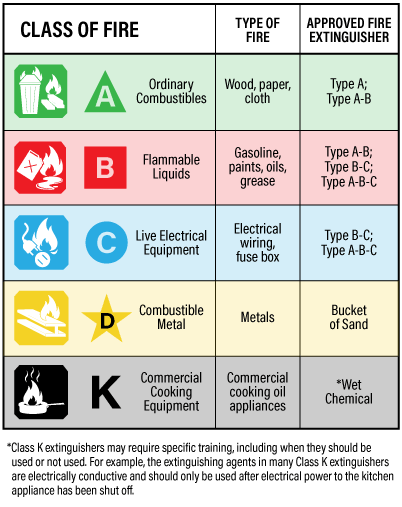
What Are The Types Of Fire Extinguishers And Their Uses Quora

What Is A Class K Fire Extinguisher Used For

Abcs Of Fire Extinguishers Fire Prevention Services The University Of Texas At Austin
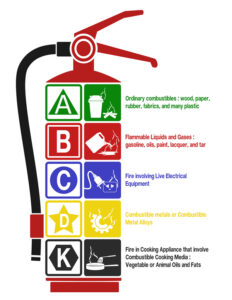
Everything You Need To Know About A Class K Fire Extinguisher

China Class K Fire Extinguisher For Kitchen Fire China Stick Type Cooking Oil Pan Fire Extinguishers Stick Pack Cooking Oil Pan Fire Extinguishers
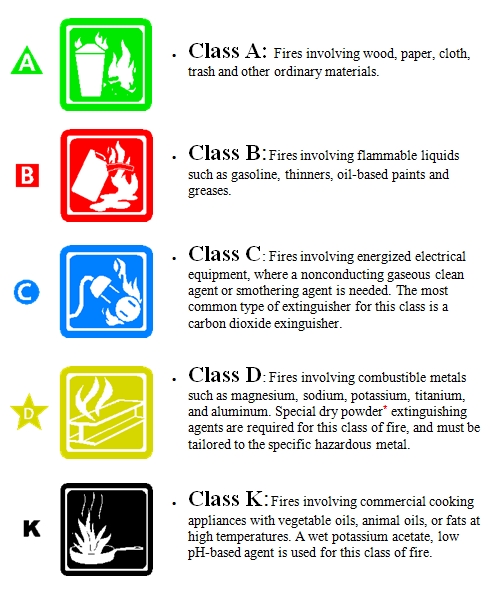
Fire Extinguishers Environmental Health And Safety

China Class K Fire Extinguisher For Kitchen Fire China Stick Type Cooking Oil Pan Fire Extinguishers Stick Pack Cooking Oil Pan Fire Extinguishers

6 Classes Of Fire You Should Know Hsewatch

The Five Classes Of Fires And The Fire Extinguishers That Stop Them Strike First Usa

China Class K Fire Extinguisher For Kitchen Fire China Stick Type Cooking Oil Pan Fire Extinguishers Stick Pack Cooking Oil Pan Fire Extinguishers

On What Classes Of Fires Can A Dry Chemical Extinguisher Be Used Quora

Find Out What The Symbols On Your Fire Extinguisher Actually Mean Foremost Promotions
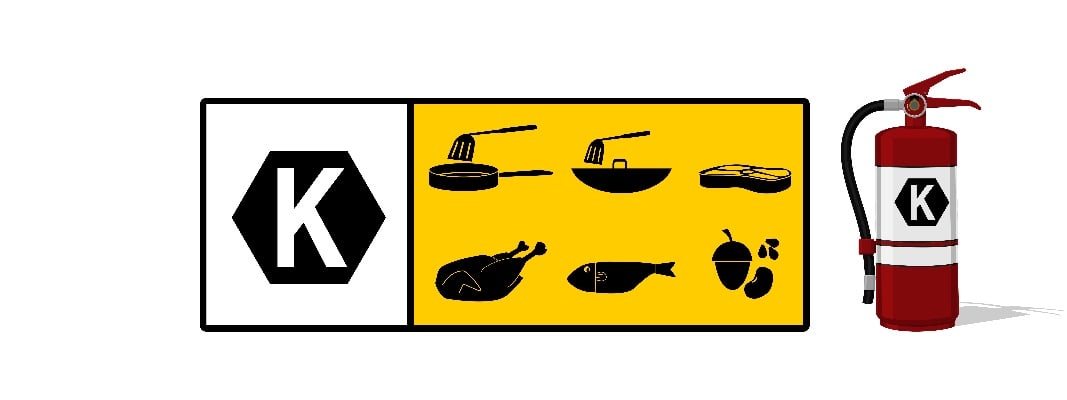
What Is A Class K Fire Extinguisher Used For

Find Out What The Symbols On Your Fire Extinguisher Actually Mean Foremost Promotions

Purple K Class Fire Extinguishers Use Classification And Model Designs Industrial And Personal Safety Products From Onlinesafetydepot Com

Everything You Need To Know About A Class K Fire Extinguisher

